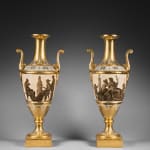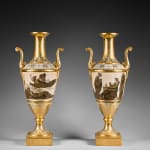Paris Porcelain
Literature
Régine de Plinval de Guillebon, Faïence et porcelaine de Paris XVIIIe-XIXe siècles, Editions Faton, Dijon, 1995, p. 403-404
A rare pair of Empire Paris porcelain spindle-shaped vases
Paris, date circa 1805-1810
Height 56.2 cm; base 13 cm x 13 cm
The two spindle-shaped vases, with elongated neck and handles, are elaborately decorated with gold motifs on a white ground and white motifs on a gold ground, including palmettes, rosettes, geometrical friezes, their bottom portions adorned with reserves and flowers against a striated ground, thyrsi entwined with grape vines, pedestals decorated with C-scrolls, palmettes and flowers; the square bases are decorated with flowers and a scale pattern centered by dots. The bellies of the vases are finely painted in gradations of brown against a cream background, forming antique-style bands that are reminiscent of red-figured Attic vases; they depict scenes from classical mythology that very likely refer to the myth of Ariadne and her half-brother the Minotaur. The first vase depicts a woman who is about to make an offering to celebrate the birth of twins who are in their mother's lap. On the back a bearded man stands and contemplates the scene; this probably represents Pasiphaë and her twins Minos and Taurus, and the architect Daedalus, who designed the famous labyrinth. The other side has a central group depicting a seated Ariadne and Dionysus facing each other, while the young Cupid holding a lance stands nearby, with a shield and a sword. The second vase shows Ariadne on the island of Dia, as she was discovered while asleep by three maenads from Dionysus' cortege, one of whom is wearing long, floating draperies. On the other side is the scene of a bearded man sitting on a klismos chair; he is wearing a pilos hat and is speaking with a woman who is holding a stick. Between them is a column surmounted by a helmeted Minerva bust; this is very likely Athena as she appeared to Theseus to announce Ariadne's engagement to Dionysus.
The rare and unusual design and decoration of the present pair of large decorative vases leads us to attribute them to the Pouyat et Russinger factory, one of the most important Parisian manufactories of the early decades of the 19th century. The factory, established in the rue Fontaine-au-Roi, had been founded by Jean-Baptiste Locré in the early 1770's. Several years later, Locré went into partnership with Laurent Russinger, who ran the factory until the late 18th century. Around 1800, the Limoges merchant François Pouyat went into partnership with Russinger and took over the firm. Pouyat continued to develop the firm's activities until 1810, then sold it to his three sons who continued to run it successfully until the Restoration. Pouyat and Russinger specialized in good quality every-day items, mostly dishes and ornamental pieces. However it occasionally produced very fine quality items, very likely on commission, including several pairs of vases with grisaille decoration, such as a pair of oval-shaped vases formerly in the collection of Michel Bloit, which is today in the Adrien Dubouché Museum in Limoges (illustrated in R. de Plinval de Guillebon, op.cit., Dijon, 1995, p. 403, fig. 395).



